14/09/2020
MUSICAL FORMS
In music, form refers to the structure of a musical composition or performance.
Musical form unfolds over time through the expansion and development of these ideas. Compositions that do not follow a fixed structure and rely more on improvisation are considered free-form.
Musical form or musical structure is a key element to any musical composition. A little like the construction of a building that determines its appearance and stability, so form in music gives a composition its distinct shape and integrity. Some musical structures are incredibly complex or grand, others more modest and easier to understand when attempting to analyze them.
If we label our musical materials, ideas, or sections with the letters of the alphabet we can show how musical forms are created.
Any single section of music, consisting of phrases or other musical sections, we can call A. This musical section can be repeated to create an AA form.
If we instead chose to add a new section, B, we would have the musical form AB. This would be two contrasting musical sections.
If we chose to add another A to an AB form, but this time with variation we would have the form ABA’. (The ‘ is used to indicate variation).
With the processes of repetition, contrast and variation there can be many musical form
Common Musical Forms
- Strophic – AAA
- Binary – AB
- Ternary – ABA
- Rondo – ABACA, or ABACADA
- Arch – ABCBA
- Sonata Form – Exposition: (Theme Group 1 – Theme Group 2) — Development — Recapitulation: (Theme Group 1 – Theme Group 2)
- Sonata Rondo – ABA – C – ABA
ASSIGNMENT
- Highlight the meaning of the following in musical context; a. Exposition b. Development c. Recapitulation
10/09/2020
Correction to the last assignment
- Different parts of acoustic guitars include; a. bridge b. strings c. tuning pegs d. fret board e. sound hole f. resonator
- The main types of guitar are; a. acoustic guitars b. electric guitars c. electro-acoustic guitars
- Six strings
07/09/2020
Good morning students, I hope you are all in good shape as we prepare to resume soon. May God Almighty continue to keep us all as we plan to resume in two weeks time. Our topic for this week is;
GUITAR
The guitar is a fretted musical instrument that usually has six strings. It is typically played with both hands by strumming or plucking the strings with either a guitar pick (plectrum) or the fingers/fingernails of one hand, while simultaneously fretting (pressing the strings against the frets) with the fingers of the other hand. The sound of the vibrating strings is projected either acoustically, by means of the hollow chamber of the guitar (for an acoustic guitar), or through an electrical amplifier and a speaker.
The guitar is a type of chordophone, traditionally constructed from wood and strung with either gut, nylon or steel strings and distinguished from other chordophones by its construction and tuning. The modern guitar was preceded by the gittern, the vihuela, the four-course Renaissance guitar, and the five-course baroque guitar, all of which contributed to the development of the modern six-string instrument.

There are three main types of modern acoustic guitar: the classical guitar (Spanish guitar/nylon-string guitar), the steel-string acoustic guitar and the archtop guitar, which is sometimes called a “jazz guitar“. The tone of an acoustic guitar is produced by the strings’ vibration, amplified by the hollow body of the guitar, which acts as a resonating chamber.

TYPES OF GUITAR
There are 3 basic types of guitar which include;
-Classical guitar
– Acoustic guitar and
-Electric guitar
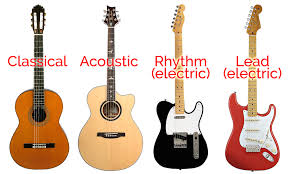
Assignment
- Highlight four parts of acoustic guitars.
- Mention two types of guitar
- How many strings has a standard acoustic guitar?
Correction to the last assignment
- A
- E
- C#
- C#
- C
- A
- E
- D
- G
- B
30/08/2020
Hello students, I believe you are all in good health and sound mind.
Apologies for my inability to take a class with you last week, it was due to technical reasons. I promise it will not repeat itself. The topic for this week is;
MAJOR SCALE
A major scale is a diatonic scale. The sequence of intervals between the notes of a major scale is: whole, whole, half, whole, whole, whole, half. where “whole” stands for a whole tone.
C Major Scale
Notes of the C Major Scale on a piano keyboard and in ascending order on a staff:
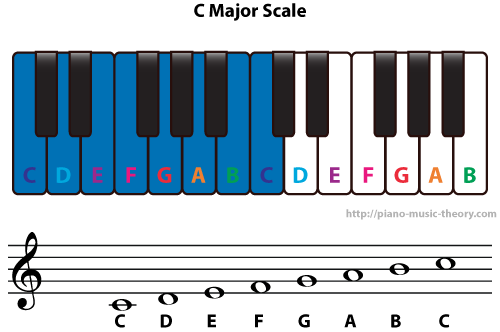
C Major Key Signature
The key signature of C major scale has no sharp or flat. All notes in the C major scale are natural notes.
C major scale is the relative major of A minor scale. C major and A minor scales have the same key signature.
F Major Scale
F – G – A – B♭ – C – D – E – F are the notes of the F major scale.
Notes of the F Major Scale on a piano keyboard and in ascending order on a staff:
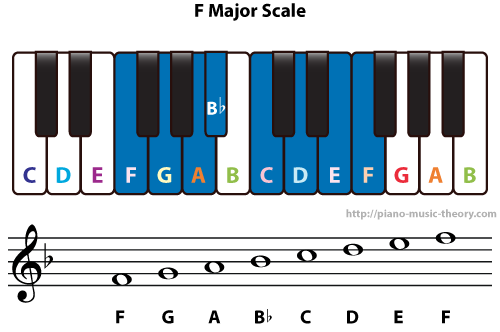
F Major Key Signature
The key signature of F major scale has only one B♭.
F major scale is the relative major of D minor scale. F major and D minor scales have the same flat key signature.
G Major Scale
G – A – B – C – D – E – F♯ – G are the notes of the G major scale.
Notes of the G Major Scale on a piano keyboard and in ascending order on a staff:
G Major Key Signature
The key signature of G major scale has only one F♯.

G major scale is the relative major of E minor scale. G major and E minor scales have the same sharp key signature.
List of all Major Scales
Major scale with no sharp or flat:
C Major Scale: C – D – E – F – G – A – B – C
Major scales with sharps:
G Major Scale: G – A – B – C – D – E – F♯ – G
D Major Scale: D – E – F♯ – G – A – B – C♯ – D
A Major Scale: A – B – C♯ – D – E – F♯ – G♯ – A
E Major Scale: E – F♯ – G♯ – A – B – C♯ – D♯ – E
Major scales with flats:
F Major Scale: F – G – A – B♭ – C – D – E – F
B Flat Major Scale: B♭ – C – D – E♭ – F – G – A – B♭
E Flat Major Scale: E♭ – F – G – A♭ – B♭ – C – D – E♭
A Flat Major Scale: A♭ – B♭ – C – D♭ – E♭ – F – G – A♭
Assignment
Identify the appropriate degree or note of the scales below.
Q 1. What is the 4th tone of the E major scale?
____________________________ .
Q 2. What is the 6th tone of the G major scale?
____________________________ .
Q 3. What is the 2nd tone of the B major scale?
____________________________ .
Q 4. What is the 7th tone of the D major scale?
____________________________ .
Q 5. What is the 5th tone of the F major scale?
____________________________ .
Q 6. What is the 1st tone of the A major scale?
____________________________ .
Q 7. What is the 3rd tone of the C major scale?
____________________________ .
Q 8. What is the 6th tone of the F major scale?
____________________________ .
Q 9. What is the 2nd tone of the F major scale?
____________________________ .
Q 10. What is the 7th tone of the C major scale?
____________________________ .
18/08/2020
Good morning students. I believe you had a peaceful night next rest.
This is the correction to the last assignment given.
- B
2. C
3. A
4. A
5. C
17/08/2020
Good morning articulate students. I believe you are all doing great.
Please, the topic for this week is a bit lengthy because it has to do with history. we would study some today and continue next week by God’s grace. Take your time and read through, then attempt the questions given below.
HISTORY OF MUSIC
Western classical music history is traditionally understood as beginning with plainchant (also called “Gregorian” chant), the vocal religious practice of the Roman Catholic Church. Plainchant was transmitted by memory until the early 9th century, when the Holy Roman Emperor Charlemagne arranged for it to be notated, and for standardized plainchant books to be distributed to churches and monasteries across Europe. Limited in pitch range and monophonic (i.e., composed of a single melody with no accompaniment), plainchant was sung largely by monks, nuns, and clerics rather than by professional singers. Plainchant was sung in the Divine Offices, eight daily prayer services using Old Testament texts, and in the Mass, a midmorning celebration of the life and death of Jesus Christ. The Alleluia reproduced here was a chant of jubilation (“Alleluia” = “Hallelujah”), sung as part of the Mass.
The six (6) musical periods are classified as Medieval, Renaissance, Baroque, Classical, Romantic, and 20th/21st Century, with each fitting into an approximate time frame.
Medieval (1150 – 1400)
Though we can assume that music began far before 1150, the Medieval period is the first in which we can be sure as to how music sounded during this time. Most notated manuscripts from the Medieval period came from the church or places connected to the church, and so most pieces have a religious subject.
Instruments used during this time included the flute, the recorder, and plucked string instruments, like the lute. Early versions of the organ and fiddle also existed.
Perhaps the most known type of music to come out of the Medieval period was the Gregorian Chant. Gregorian Chants were monophonic, (a single, unaccompanied melodic line) and most commonly sung by monks. Take a moment to listen to the Gregorian Chant below. Notice the notation in the background as well, which has also drastically changed over time.
Though the monophonic style was a staple in the Medieval period, it’s important to note that polyphonic vocal genres also developed in this time. Polyphony is the use of multiple independent voice types, as opposed to the one melody line in monophonic singing.
Though a large portion of the music written in this era is not attributed to any author, John Dunstable, Adam de la Halle, Phillippe de Vitry, Guillaume de Machaut, and Francesco Landini were all notable composers in this period.
Assignment
1. A single unaccompanied melodic line is referred to as __________ . A. homophonic B. monophonic C. polyphony D. cacophony
2. Plainchant could also be referred to as ___________ . A. Pauline Chant B. Aculian Chant C. Gregorian Chant D. None of the above
3. One of these periods lasted between 1150 and 1400. A. Medieval B. Baroque C. Renaissance D. Classical
4. Instrumentation became more prominent in one of the following periods. A. Renaissance B. Baroque C. Middle Ages D. 20th century
- 5. Which instrument was invented during the Renaissance period?
A. Viola
B. Violin
C. Viol
D. Violoncello
Renaissance (1400 – 1600)
The Renaissance brought significantly increased amounts of harmony and polyphony into music, as most composers were focused on choral music.
The Renaissance was a golden age for choral composition, especially in acapella compositions.
Religious music continued to flourish throughout the entire Renaissance period, including new forms such as masses, anthems, psalms, and motets. Some composers of sacred music began to adopt secular forms (such as the madrigal) towards the end of the period. Take a moment to listen to “The Silver Swan,” a famous choral piece still sung today by composer Orlando Gibbons.
Instrumentation became more prominent during this period, with the introduction of:
- Early brass instruments: slide trumpet, cornet, valveless trumpet, sackbut
- Adapted string instruments: viol, rebec, lyre, lute, guitar
- The harpsichord
- Small percussion instruments: triangle, tambourine, bells, small drums
- Early woodwind instruments: reed pipe, bagpipe, transverse flute, recorder
The second half of the Renaissance period was incredibly influential, as composers became to move away from the modal system of harmony and towards the organization of major and minor scales.
The strong sensation of each piece having a definitely tonal center (or key) became commonplace in the Renaissance period.
Notable composers of the Renaissance include William Byrd, John Dowland, Orlando Gibbons, Giovanni Pierluigi da Palestrina, and Thomas Tallis.
13/08/2020
Correction to the last assignment
- A
- C
- B
- B
- B
10/08/2020
Good morning students. Hope you are all doing fine. May God Almighty continue to bless your memory. The topic for this week is:
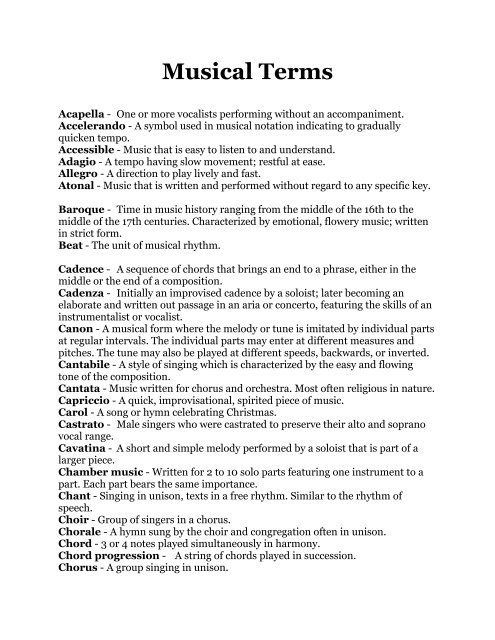
Musical Terms and signs in common use
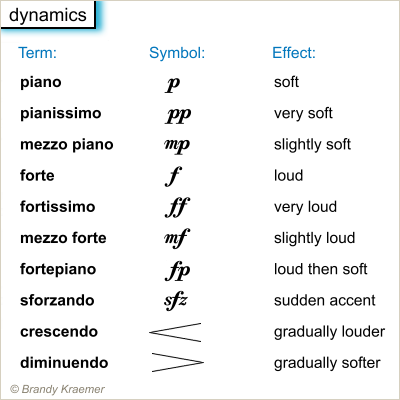
Assignment
- A sequence of chord that brings an end to a phrase, either in the middle in the middle or end of a music composition is known as ________. (A) cadence (B) chord (C) canon (B) beat
- Which of the following is referred to as the unit of musical rhythm. (A) Cavatina (B) Chant (C) Beat (D) Adagio
- A group of singers in a chorus is known as ______. (A) chorale (B) choir (C) chord (D) carol
- The symbol or sign for “very loud” is ____. (A) f (B) ff (C) mp (D) mf
- The symbol < means _________ . (A) sudden accent (B) gradually louder (C) gradually softer (D) soft
Correction to the last assignment
- Triad is the chord of three notes consisting of the root, third and fifth above.
- The major triads in roman numerals are I, IV, V.
- The meaning of ‘M3’ is Major 3rd while ‘m3’ is minor 3rd.
03/08/2020
Hello excellent students on this platform. I hope you are doing great at home.
It is well with you all in Jesus name. Do not forget to copy this note in your school notebook.
Tonic Triad
In music theory, scale degrees are the most common way of describing and analyzing consecutive tonal harmonies; two identical chords/chord progressions are written in the same way regardless of the key. The labeling is based on triads built on the notes of a scale and numbered I … VII, counting from the tonic. The most common triads in any key are the tonic (I) and dominant (V).
A tonic triad is a chord of three notes, with the lowest note being the tonic.
In C major the first note of the scale is a C. Therefore the tonic triad starts on a C. The second note in the triad is, as we discussed earlier, a third above the starting note. This means as C is the starting note, a third above C is E. So the first to notes are C and E.
The tonic is the first (and last) note in a scale. “Triad” means “chord built with thirds”.
A “tonic triad” is a music theory term for a chord of three notes and the lowest of these notes is the tonic of the key we are in.
Here’s a tonic triad Tonic triads are always made up of the tonic, third and fifth notes of the scale.
We say that tonic triads are built out of thirds, because the interval between the lowest note and the middle note is a third, and the interval between the middle note and the highest note is also a third.

C D E F G A B
The notes of each triad can be seen to represent a certain degree of a key. A tonic chord includes the 1st, 3rd, and 5th degrees, the most stable degrees of a key. On the other hand, the VII chord includes the 2nd, 4th, and 7th degrees, the most active degrees of a key. It is common to see a chord as a structure of thirds. The superimposed thirds can be major (M3) or minor (m3), which gives us triads of four types:
M3 + m3 = major triad
m3 + M3 = minor triad
m3 + m3 = diminished triad
M3 + M3 = augmented triad
Assignment
- What is tonic triad?
- mention the major triads in roman numerals.
- Highlight the meaning of ‘M3’ and ‘m3’.
27/07/2020
Good morning students. I hope you all had a nice weekend. May God’s name be praised for His grace, mercy, favour and protection over us. Please, ensure that you copy this note in your school notebook. Our topic for this week shall be:
ELEMENTS OF MUSIC
The elements of music can be seen as being the building blocks of music. Without them, music (of any style/age) would not exist because sound itself would not exist.
Think of the elements of music like the crucial elements of a car. A car needs wheels, an engine, brakes, doors, a chassis, a steering wheel, etc.. Without these key elements it will no longer be a car. Without the key musical elements a piece of music will no longer be music.
WHAT ARE THE ELEMENTS OF MUSIC?
Here is a quick run through of the main musical elements (you may come across variations of this, but these are the crucial ones):
-Accent: An accent mark, also referred to as an articulation mark, indicates that a louder dynamic shall be applied to a particular note. Accent also is used as a term to indicate any notes and signs that require sound emphasis. On musical instruments with a range of dynamic distinction, the prominence or emphasis is in the form of an increase in volume, commonly happening at the start or even a moment after the start.
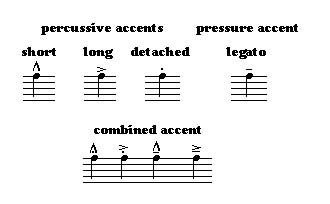
-Tie: A tie is a curved, horizontal line that connects two music notes of the same pitch (as opposed to legato, which connects two or more different pitches). Tied notes are held for the length of both notes; only the first is struck.
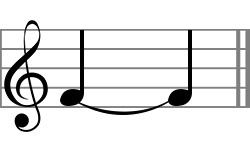
–Beat: In music and music theory, the beat is the basic unit of time, the pulse (regularly repeating event), of the mensural level (or beat level). … In popular use, beat can refer to a variety of related concepts, including pulse, tempo, meter, specific rhythms, and groove.


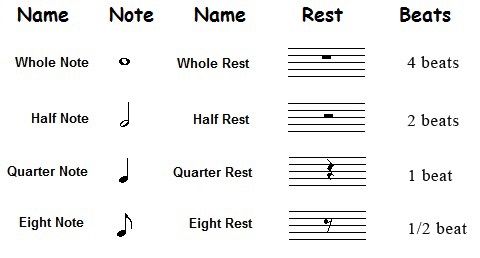
-Tempo: The tempo of a piece of music is the speed of the underlying beat. Like a heartbeat, it can also be thought of as the ‘pulse’ of the music. Tempo is measured in BPM, or beats per minute. Sometimes the tempo is written at the beginning of the music and is called a metronome marking.
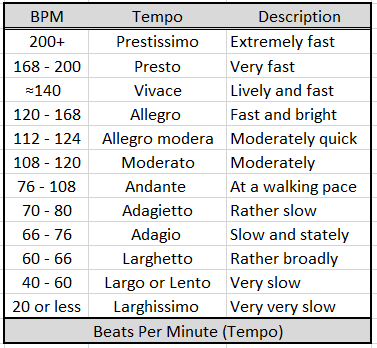
OTHER ELEMENTS OF MUSIC
Pitch – how high or low a note sounds.
Rhythm – the pattern of regular or irregular pulses caused in music by the occurrence of strong and weak beats. (In everyday language this is the “groove”).
Duration – the length of a musical note.
Structure – the way in which an overall piece of music is arranged into similar and contrasting sections.
Dynamics – how loud/quiet the music is (either the overall sound or of individual notes/instruments within it).
Texture – the way in which melody, rhythm and harmony are combined in a piece of music. What each part/instrument is doing at any given point.
Timbre – the tone of a musical note.
Tonality – the key in which a piece is written (can change as piece progresses).
Harmony – the relationship between 2 or more simultaneously sounding notes.
ASSIGNMENT
- The following are elements of music EXCEPT A. tempo B. rhythm C. accent D. triad
- One of the following elements of music determines the high or low of music. A. pitch B. dynamics C. duration D. tempo
- One of these determines the loud and soft or quietness of music. A. Tonality B. Dynamics C. Duration D. Accent
- One of these means slow and stately. A. Vivace B. Presto C. Adagio D. Allegro
- Music beat could also be referred to as _________ . A. pulse B. key signature C. accent D. syncopation
21/07/2020
Correction to the last assignment
- D
- A
- B
- D
- C
Good morning students, I believe all is well with you. Please, remember you are duty bound to copy all these notes in your School notebook for reference purposes. May God increase your knowledge, wisdom and understanding.
20/07/2020 Dotted Notes and Rests
In Western musical notation, a dotted note is a note with a small dot written after it. In modern practice, the first dot increases the duration of the basic note by half (the original note with an extra beam) of its original value. This means that a dotted note is equivalent to writing the basic note tied to a note of half the value – for instance, a dotted half note is equivalent to a half note tied to a quarter note. Subsequent dots add progressively halved value, as shown in the example to the right. Though theoretically possible, a note with more than three dots is highly uncommon; only quadruple dots have been attested. If the original note is considered as being of length 1, then a quintuple dot would only be 1/32 longer than the quadruple dotted note. The difficulty may be seen by comparing dotted notation to tied notation: a quarter note is equivalent to 2 tied 8th notes, a dotted quarter = 3 tied 8th notes, double dotted = 7 tied 16th notes, triple dotted = 15 tied 32nd notes, and quadruple dotted = 31 tied 64th notes. Although shorter notes do occur 64th notes are considered the shortest practical duration found in musical notation.
| Dotted Notes and Rests and their duration | |||||
| Dotted Note | Dotted Rest | No Dots | One Dot | Two Dots | Three Dots |
| whole note | whole rest | 4 | 6 | 7 | 7 1/2 |
| half note | half rest | 2 | 3 | 3 1/2 | 3 /3/4 |
| quarter note | quarter rest | 1 | 1 1/2 | 1 3/4 | 1 7/8 |
| eighth note | eighth rest | 1/2 | 3/4 | 7/8 | 15/16 |
| sixteenth note | sixteenth rest | 1/4 | 3/8 | 7/16 | 15/32 |
Dotted Whole Note
As mentioned above, we see that when we add a dot to the whole note, its value or duration is extended by half its original length. Thus, the whole note now lasts for 6 beats. Note that the location of the dot is always to the right of the note head.

__ 4+2 = 6 beats
Dotted Half Note

__ 2+1 = 3 beats
As we can see, if a dot is added to a half note, its duration is increased by half its original value. Thus, the dotted half note lasts for 3 beats.
Dotted Quarter Note

1+1/2 = 11/2 beats
From our knowledge of what a dot does to a note, we can easily calculate that the duration of a dotted quarter note is 1 1/2 beats.
Dotted Eighth Note

= 1/2+1/4= 3/4
Before we calculate the duration of a dotted quarter note, let’s first recall the duration of an ordinary eighth note: 1/2 beat. Now if we are to add on half of this value to the eighth note’s value, we will get a total of 3/4 beat. Therefore, a dotted eighth note lasts for 3/4 beat.
Can you guess for how many beats a dotted sixteenth note lasts? I won’t go into it at this level simply because it would mean having to teach a note that is not required at this level.
Dotted Rests
Just as there are dotted notes, so too are there dotted rests! Let’s get straight into it:
Dotted Semibreve Rest

A dotted semibreve rest is pictured on the left. Remember, a semibreve rest hangs from the fourth line of the staff. Instead of the regular 4 beats of silence, a dotted semibreve rest lasts for 6 beats of silence.
Dotted Minim Rest

Ordinarily, a minim rest would last for 2 beats. With the added dot, it lasts for 3 beats.
Dotted Crotchet Rest

By now you could predict what I’m going to write here. If you said 1 1/2 beats, then you’re right!
Dotted Quaver Rest

A dotted quaver rest lasts for 3/4 beat.
Assignment
- A dot applied after a semibreve note equals _____ beats. A. 9 B. 8 C. 7 D. 6
- A dot applied after a minim note equals _____ beats. A. 3 B. 4 C. 5 D. 4
- Double dot after a semibreve note equals _____ beats. A. 6 B. 7 C. 8 D. 9
- The implication of a dot applied means _____ the value of the main note. A. quarter B. whole C. eighth D. half
- Another name for semibreve note is _______ note. A. quarter B. half C. whole D. sixteenth
14/07/2020 Correction to the last assignment
- C or D
- A
- C
- C
13/07/2020 MUSICAL NOTES AND PROPORTIONAL RESTS
A rest is a musical notation sign that indicates the absence of a sound.
Each rest symbol and name corresponds with a particular note value for length, indicating how long the silence should last.
Musical note and rest values are not absolutely defined, but are proportional in duration to all other note and rest values. The whole note is the reference value, and the other notes are named (in American usage) in comparison; i.e., a quarter note is a quarter of the length of a whole note.

Assignment
1. There are ______ quarter notes in a whole note.
A. 6 B.5 C.4 D.4
2. Which of the following is the longest note?
A. Quarter note B. Eighth note C. sixteenth note D. Thirty-second note
3. Quarter note is equal to ______ beats.
A. 16 B. 8 C. 4 D. 2
4. Rest is the period of ______ in music.
A. continuity B. loudness C. silence D. waiting
07/07/2020 CORRECTION TO THE LAST ASSIGNMENT
1. A
2. B
3. B
4. C
5. C
06/07/2020 MUSICAL KEYBOARD
A musical keyboard is the set of adjacent depressible levers or keys on a musical instrument. Keyboards typically contain keys for playing the twelve notes of the Western musical scale, with a combination of larger, longer keys and smaller, shorter keys that repeats at the interval of an octave. Depressing a key on the keyboard makes the instrument produce sounds—either by mechanically striking a string or tine (acoustic and electric piano, clavichord), plucking a string (harpsichord), causing air to flow through a pipe organ, striking a bell (carillon), or, on electric and electronic keyboards, completing a circuit (Hammond organ, digital piano, synthesizer). Since the most commonly encountered keyboard instrument is the piano, the keyboard layout is often referred to as the piano keyboard.

Description/characteristics
The twelve notes of the Western musical scale are laid out with the lowest note on the left; The longer keys (for the seven “natural” notes of the C major scale: C, D, E, F, G, A, B). Because these keys were traditionally covered in ivory they are often called the white notes or white keys. The keys for the remaining five notes—which are not part of the C major scale—(i.e., C♯/D♭, D♯/E♭, F♯/G♭, G♯/A♭, A♯/B♭) (Sharp and Flat) are raised and shorter. Because these keys receive less wear, they are often made of black colored wood and called the black notes or black keys. The pattern repeats at the interval of an octave.
ASSIGNMENT
- The piano keyboard has ___ white keys and ___ black notes within an octave. A. 7,5 B. 8,5 C. 6,5 D. 8,6
- The musical letters range from ____ to ____ . A. A,F B. A,G C. A,H D. A,I
- The black key after ‘F’ is called ______ A. E# B. F# C. G# D. A#
- While the white keys are referred to as natural keys, the black keys are referred to as ____________ keys. A. artificial B. acute C. accidental D. non of the above
- One of the following shares the same black note with A# A. Db B. Ab C. Bb D. Gb
30/06/2020
Good afternoon students.
Correction to the last assignment given
- five lines, four spaces
- ledger line
- middle C
- Seven English alphabets (A, B, C, D, E, F, G)
29/06/2020
Ledger Lines
This lesson is all about ledger lines. What are they?
First of all, to better understand what they are, we need to know what a staff is. The musical staff is the foundation upon which notes are drawn. It comprises five lines and four spaces. Every line or space on the staff represents a white key on your piano.
There are two staves (plural for staff). There is a treble staff and a bass staff with a treble clef and bass clef, respectively. The notes of the lines on the treble staff from bottom to top are E-G-B-D-F while the notes of the spaces are F-A-C-E. For the bass staff, the notes of the lines from bottom to top are G-B-D-F-A. The notes of the spaces for the bass staff are A-C-E-G. This would give us a total of 9 notes for the treble staff and 9 notes for the bass staff.
The grand staff can only accommodate twenty-one notes. What about all the other notes on the piano? After all some keyboards have 61 and 76 keys and a piano has as many as 88 keys.
What seems like a problem is solved by ledger lines. When we run out of room on the staff we add ledger (or leger) lines. These very short lines extend the 5 lines and 4 spaces staff, allowing us to add extra notes. They can be added above or below the treble and bass staff. Those below the staff are the lower notes, while those above are higher notes.

As a beginner, the first leger line you should learn is middle C. On the grand staff, middle C is located between the treble and bass staff, as shown in the diagram on the right.
On piano, if middle C is written with a ledger line below the treble staff, you play it with your right hand. If the line is above the bass staff you play it with your left hand. Middle C is located in the middle of your piano.


Assignment
- How many lines and spaces has a staff?
- What do we use to show the extension of a staff?
- The ledger line between the treble and bass staff is called ______ .
- How many letters of the English alphabet are used to name the pitches of music?
Hello students, I believe you are staying healthy and safe.
please ensure that you copy the scheme of work for next term provided below in your school notebook.
Weeks Topics
1. Ledger line
-Ledger lines above and below
2. Keyboard
-Introduction to keyboard
Characteristics of keyboard
3. Construction of simple musical instrument
4. Recorder playing
5. Rests
-Notes and Rest proportional length
6. Dotted notes and Dotted rests
7. Accents/ Tie/ Beat and Tempo
8. Recorder playing
9. Revision
10. Examination Begins
11. Examination continues
12. Collation of results
13. End of result collation/ Distribution of results
22/06/2020
Good morning students. I believe you are doing great and staying safe. I want to say well done for your consistency on this platform. May you be wiser and more knowledgeable in Jesus name. Please be reminded again that it is expedient for you to copy this notes for future purposes.
Our topic for this week is;
SOUND
Sound is the sensation affecting the organs of hearing. It can also be described as vibrations that can be perceived by the ear. There two basic sources of sound namely:
- Natural sources of sound
- Sound produced through musical instruments.
USES OF SOUND
- Sound is used for listening pleasure of an individual.
- Sound is used for communication.
- Sound is also basically used for musical production
Characteristics of sound
Sound can be characterized by the following qualities:
- Pitch
- Loudness
- Tone Colours
Pitch: It refers to the frequency of a sound as felt by human ear. The degree of highness of lowliness of a sound is referred to as pitch. A high frequency gives rise to a high pitch note and a low frequency produces a low pitch note.
Loudness: Refers to the amount or strength of sound and are shown by two basic Italians words p or piano (soft) and f or forte (loud).
Tone Colours: Otherwise known as timbre. The distinctive sound or a voice of musical instrument is called its timbre or tone colours.
Correction
- b soft
- b f
- a tone colour
- c duration
15/06/2020
Good morning students, I believe you are all staying safe and healthy. May God continue to keep us all alive.
The topic for this week is;
Characteristics/ Properties of Musical Sound
Musical sound is characterized by the following;
- Pitch or Frequency
- Intensity or Loudness
- Quality or Timber or Tone Colour
- Duration
- PITCH: This refers to the highness or lowness of sound as felt by human ear. A high frequency gives rise to high pitch note and a low frequency produces a low pitch note.
- INTENSITY: It refers to the amount or strength of sound and are shown by two basic Italian words or symbol(P) or piano (soft) and (f) or forte (loud). The sound could be as soft as possible and as loud as possible.
- QUALITY/ TIMBRE: The quality of a musical note is that property which enables us to distinguish it from another note of the same pitch and loudness. The more the sounds, the more the quality. For instance, when a single instrument is used to produce a sound, the quality is rather small compared to when there is more musical instrument combined together.
- DURATION: This is the length of time for which the tone sounds.
Assignment
- Piano in music means ………….. . a Loud b. soft c. very soft d. very loud
- The letter symbol for loud is ……….. . a. l b. f c. p d. lp
- Quality and Timbre in music could also be referred to as …………. . a. tone colour b. tone c. form d. tone sound
- The length of time for which tone sounds in music is ………….. . a. pitch b. intensity c. duration d. quality
08/06/2020
Good morning students, I hope your night was splendid.
Please, I would like to enjoin you all to copy all the notes giving so far in a note or your CCA 2 notebook for future purposes. May God Almighty increase your wisdom, knowledge and understanding in Jesus name.
Our topic for this week is;
BAR LINES
Bar lines are lines vertically drawn across the musical staff to divide a piece of music into an equal part and to the accented beat. eg
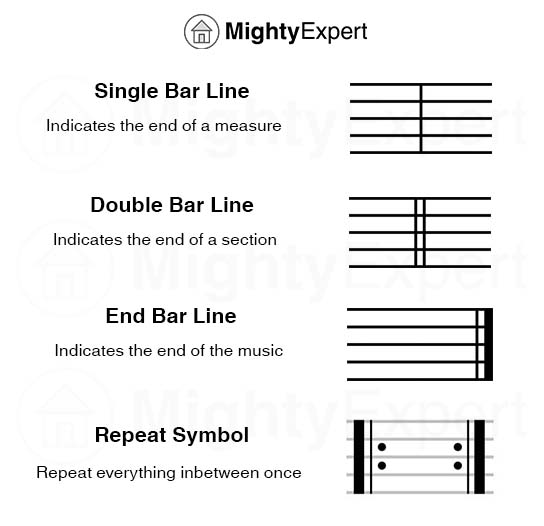
TYPES OF BAR LINE
There are two types of bar line which include;
- Single bar line
- Double bar line
- SINGLE BARLINE: Single bar line is the line drawn between the staff or a section of a musical piece. e.g
- DOUBLE BAR LINE: Double bar lines are the lines drawn at the end of the musical piece or a section of a musical piece. The double bar lines could also be used to end a section of music within an entire piece of music. e.g
BAR
A bar in music is the distance between two bar lines. Bars in music are used to regulate music timing and duration.
ASSIGNMENT
- What is musical staff?
- Mention the two major types of staff.
- Differentiate between single bar line and double bar lines.
01/06/2020 JSS1
AFRICAN TRADITIONAL MUSICAL INSTRUMENTS
In Africa, the materials available to a society and life style of the people naturally determine the kind of musical instruments to be used in the performance of music. African music therefore makes use of an enormous variety of percussion, string and wind instruments.
Generally, there are four classes of African musical instruments:
Idiophones, membranophones, aero phones and chordophones. This ethno musicological classification was formulated by a German ethnomusicologist, CURT SACHS.
These instruments are thus classified under four groups. They are:
- Membranophones
- Aerophones
- Chordophones
- Idiophones
CLASS ACTIVITY:
Explain the African traditional musical instruments below:
- Membranophones
- Aerophones
- Chordophones
- Idiophones
01/06/2020 CORRECTION
Short notes on:
-Town Crying
-Night Watching and Guarding
-Trading and Auctioning
- TOWN CRYING: This has to with the use of local musical instrument by the king’s messenger to disseminate information to the people living within the community. Examples include; Agogo, Alo, Oghene (gong), Ekutu (Animal horn), etc.
- NIGHT WATCHING AND GUARDING: The night guards use the local musical instrument to announce their arrival to guard or watch over the community or street through the night. Examples of the local musical instruments include; Gong, Animal Horn, etc.
- TRADING AND AUCTIONING: Local musical instruments could also be used to advertise goods and services. This is because they could easily be used to draw the attention costumers. Examples include; Bell, Horn, Gong, etc.
Hello wonderful students!
It’s been a while, i miss you all so much.
I believe you are staying safe and healthy.
May God see us through this pandemic period in Jesus name.
We shall be having our classes on this platform for now.
It promises to be interesting.
Our topic for this week is:
NON-MUSICAL FUNCTIONS OF MUSICAL INSTRUMENTS
In the olden days, musical instruments in Africa were being used non-musically. Many examples of this abound in the cultural life of the traditional dwellers. Some are as listed below:
1. Town crying
2. Night watching or Guarding
3. Ritual homage
4. Time keeping
5. Trading and Auctioning
All the above ways were very prominent in the use of African musical instruments non-musically.
Assignment
1. write short notes on the following non-musical uses of African musical instruments;
a. Night Watching and Guarding
b. Time keeping
c. Trading and Auctioning
No Fields Found.